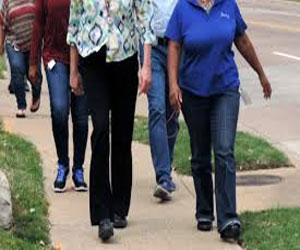- Home
- Editorial
- News
- Practice Guidelines
- Anesthesiology Guidelines
- Cancer Guidelines
- Cardiac Sciences Guidelines
- Critical Care Guidelines
- Dentistry Guidelines
- Dermatology Guidelines
- Diabetes and Endo Guidelines
- Diagnostics Guidelines
- ENT Guidelines
- Featured Practice Guidelines
- Gastroenterology Guidelines
- Geriatrics Guidelines
- Medicine Guidelines
- Nephrology Guidelines
- Neurosciences Guidelines
- Obs and Gynae Guidelines
- Ophthalmology Guidelines
- Orthopaedics Guidelines
- Paediatrics Guidelines
- Psychiatry Guidelines
- Pulmonology Guidelines
- Radiology Guidelines
- Surgery Guidelines
- Urology Guidelines
Exercise including walking and strength training reduces liver cirrhosis related deaths

According to research presented at Digestive Disease Week® (DDW) 2019, Exercise including walking and muscle-strengthening activities, were associated with significantly reduced risk of cirrhosis-related death,
"The benefit of exercise is not a new concept, but the impact of exercise on mortality from cirrhosis and from liver cancer has not yet been explored on this scale," said Tracey Simon, MD, lead researcher on the study and instructor of medicine at Harvard Medical School and Massachusetts General Hospital, Boston. "Our findings show that both walking and strength training contribute to substantial reductions in risk of cirrhosis-related death, which is significant because we know very little about modifiable risk factors."
Chronic liver disease is increasing, partly due to the obesity epidemic, and currently there are no guidelines for the optimal type of exercise for the prevention of cirrhosis-related mortality. Researchers hope these findings will help provide specific exercise recommendations for patients at risk for cirrhosis and its complications.
Dr. Simon and her team prospectively followed 68,449 women from the Nurses' Health Study and 48,748 men from the Health Professionals Follow-up Study, without known liver disease at baseline. Participants provided highly accurate data on physical activity, including type and intensity, every two years from 1986 through 2012, which allowed researchers to prospectively examine the association between physical activity and cirrhosis-related death.
Researchers observed that adults in the highest quintile of weekly walking activity had 73 percent lower risk for cirrhosis-related death than those in the lowest quintile. Further risk reduction was observed with combined walking and muscle-strengthening exercises.
Previous research has been limited to studies that assessed physical activity at just one point in time, or studies with very short-term follow-up. This was the first prospective study in a large U.S. population to include detailed and updated measurements of physical activity over such a prolonged period, which allowed researchers to more precisely estimate the relationship between physical activity and liver-related outcomes.
"In the U.S., mortality due to cirrhosis is increasing dramatically, with rates expected to triple by the year 2030. In the face of this alarming trend, information on modifiable risk factors that might prevent liver disease is needed," said Dr. Simon. "Our findings support further research to define the optimal type and intensity of physical activity to prevent adverse outcomes in patients at risk for cirrhosis."

Disclaimer: This site is primarily intended for healthcare professionals. Any content/information on this website does not replace the advice of medical and/or health professionals and should not be construed as medical/diagnostic advice/endorsement or prescription. Use of this site is subject to our terms of use, privacy policy, advertisement policy. © 2020 Minerva Medical Treatment Pvt Ltd